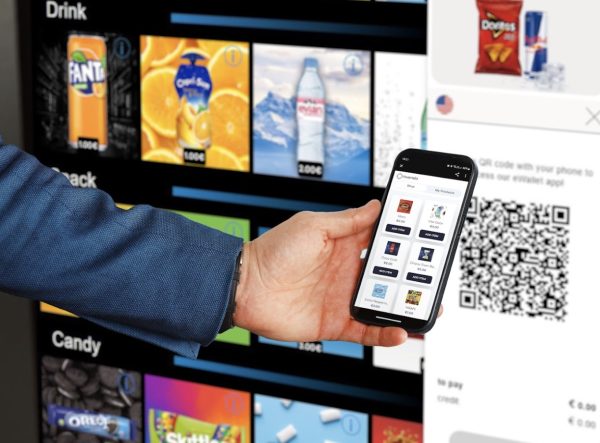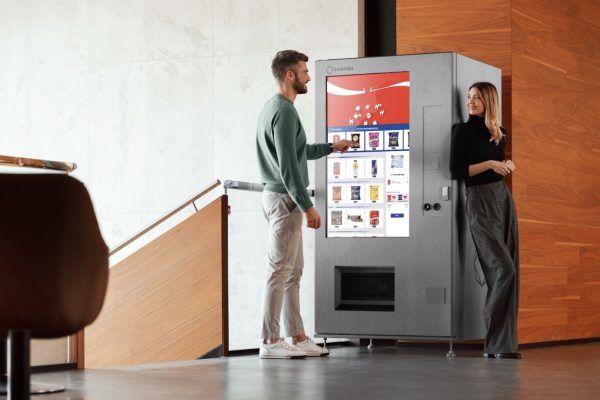Invenda Group AG is a company that has developed a connected ecosystem of software, hardware, advertising, data collection, payment, and services focused on the automated retail industry. Based in Alpnach, Switzerland, the company has offices and showrooms in London, Berlin, Stockholm, Novi Sad, and Hong Kong, and a new US office and showroom are to be opened this year.
Invenda is partnered with Microsoft and Intel and boasts existing clients including Mars Wrigley, Coca-Cola, Selecta, and Valora. The company raised $19 million in March. To learn more about the company, Pulse 2.0 interviewed Invenda founder and CEO Jon Brezinski.
Jon Brezinski’s Background
Brezinski’s background is in management information systems and computer science with extensive experience in both telecommunications and oil and gas.
“Before starting Invenda, I worked as a management consultant for Xerox [now Conduent] where I was responsible for the design and deployment of ticket vending solutions,” said Brezinski.
Idea For Invenda

How did the idea for Invenda come together? Brezinski said that one of his projects for Xerox was the Southeastern Pennsylvania Transportation Authority (SEPTA) project. He realized they were installing high-tech ticket machines globally next to vending machines that had been fully neglected from modernization or innovation since he was a boy – which as a result were undervalued and underutilized.
Hundreds of people every day would walk past these machines and rarely give them a second glance, but they were taking up prime real estate. So Brezinski took a closer look at the world of vending machines and found that they are the crux of the automated retail industry.
“This part of the retail world is made up of vending machines, kiosks, smart fridges, micro markets, etc. that enable people to buy goods without the help of another human. It’s a huge market, worth about $18 billion. This got me thinking about ways to use the space and the machines more effectively and that led to the idea behind Invenda,” Brezinski added. “I wanted to build a solution that could leverage cutting-edge AI, IoT, and cloud technology to optimize these decentralized retail assets and unlock their full potential. I didn’t have a name for the concept at the time, but now we’re calling the future of this space the Internet of Retail [IoR]. IoR facilitates highly engaging retail experiences for consumers while driving sales and insights for operators and brands. Through IoR, brands, operators, customers, advertisers, and partners can all benefit from increased efficiency, cost savings, and improved user experiences.”
When Brezinski wrapped up the program with Xerox, he was able to convince some of the key team members to join him in creating Invenda. Then they built the products and company from the ground up with a group of skilled and experienced tech professionals and partners like Intel and Microsoft.
“Vending machine technology is a lot more nuanced and sophisticated than most people realize–we had to combine analog hardware with non-existent software. Being able to start Invenda with a group that was familiar with the technology and the industry gave us an enormous leg up,” Brezinski acknowledged.
Challenges Faced Building Invenda
What were some of the challenges you faced in building the company? Brezinski noted that it turns out Intel was working on something similar and they invited him to a trade show to look around.
“I checked out what was considered the ‘latest and greatest’ in vending and it was awful – there was no technology or innovation at all. The concepts of an enhanced consumer experience, sustainability, or remote fleet management were basically non-existent,” Brezinski reflected. “When I started building Invenda, one of the biggest hurdles I faced was convincing industry veterans about the potential of our technology. Even with Intel’s support, many still believed that people wouldn’t use credit cards to buy candy and that brighter light bulbs were the epitome of vending innovation. Based on our partnerships and success now, we know that thinking was misguided! At the time, the resistance to change was frustrating – automated retail had been a stable industry for decades and many wanted to leave good enough alone. But the lack of enthusiasm only fueled my determination to disrupt the industry with our technology.”
Core Products

What are Invenda’s core products and features? “We’re a software company for automated retail and the Invenda Platform is our core. Like I mentioned, no one in the industry wanted to hear how technology could uplevel their offering, so we first started with retrofit kits for existing equipment and eventually moved into manufacturing our own machines as a way of demonstrating the full value of our software,” replied Brezinski. “Our main business is software but manufacturing is a vessel for innovation we are using to drive change across the industry.”
Plus, Brezinski noted that the full ecosystem of Invenda Platform solutions enables machine manufacturers, consumer brands, and operators to reach new markets, capture unprecedented customer insights, lower operating costs, and ultimately increase profits by 60% or more per machine. This is achieved through a combination of upselling, dynamic pricing, product animations, and targeted advertising opportunities. The Invenda Platform’s range of solutions includes:
1.) Invenda Cloud – A sophisticated fleet management platform built to oversee, maintain, and upgrade automated retail networks from a central, digital location. This can include things like remote diagnostics and maintenance, as well as full transaction management from pricing and promotions, to guaranteed delivery.
2.) Invenda OS – A proprietary operating system for next-generation self-service POS devices that brings the benefits of online shopping like data collection, personalization, and targeted advertising–to the real world for brands, operators, and consumers alike.
3.) Invenda Wallet – A download-free, browser-based web app that enables mobile shopping, gamification, gifting, scratch-and-win, loyalty programs, and remote account access for consumers.
Invenda’s cloud-based ecosystem creates highly customizable new ways to engage consumers through DOOH advertising opportunities that have previously been out of reach. Invenda’s advertising capabilities close the divide between self-service interactions and high-value programmatic advertising, allowing operators to increase passive revenue and collect invaluable customer data.
Evolution Of Invenda’s Technology

How did the company’s technology evolve over time? Brezinski said that they first started by deploying a basic digital signage and menu board solution for one of their investors to understand how the industry works and what would be expected from both the consumer and operator sides. Vending machines are considered the most complex of all the automated retail devices so starting from the top and working their way down seemed to be the most efficient path. So, in parallel with the first deployments, the company’s initial strategy was to target the 15 million existing vending machines with retrofits.
“We basically intended to install touchscreens on vending machines and replace analog controllers with PCs. We were successful in developing the kits and deploying the solution, but the economics and practicalities of refurbishing and retrofitting used equipment wasn’t optimal,” Brezinski noted. “We needed to develop a solution that could compete with new equipment on the global market in price, but far exceed in technology.”
The company’s customers historically haven’t wanted change so they have to make the offering too good to pass up. Invenda started working with chassis (the base or frame of the machine) from an OEM, which they fully re-engineered to meet global safety and operational certification standards. From there, Invenda moved on to completely redesign a new chassis and solution with a focus on sustainability and efficiency in a compact size with equal or greater capacity. The next step was developing retrofit kits for smart fridges and adapting the Invenda OS to work for micro markets. Recognizing a gap in payments and seeing the evolution of QR code payments in Asia, Invenda decided to complement payment terminals with the Invenda Wallet which has evolved into gamification and cross-channel promotions.
Biggest Milestones
When I asked Brezinski about the company’s biggest milestones, he cited the funding (more details below). Brezinski also said that the total funding they raised is no small feat for a company based in a small village in the Swiss Alps. Plus for the last 3 years, the company managed to double revenue each year and they are projected to maintain this trajectory for the coming years.
Funding
The company recently closed a $19 million Series B funding round led by Point Break Capital Management, LLC with participation from existing investor Mutschler Ventures AG, which brought Invenda’s total funding to over $30 million.
Total Addressable Market
What is the total addressable market (TAM) size that Invenda is pursuing? Brezinski noted that this figure is hard to quantify, but they are trying to merge the $23 billion automated retail industry with the $28.2 billion digital out-of-home (DOOH) advertising industry to create an entirely new market.
Differentiation From The Competition
What differentiates Invenda from the competition?
“No other players in our space offer the quality and scope of capabilities and flexibility that the Invenda Platform does. A basic telemetry system can only deliver a baby step in the right direction. Additionally, OEMs don’t have the time or know-how to make software innovation a priority which is why we’re partnering with them to do this leg work while they continue to excel in manufacturing,” Brezinski pointed out. “Other startups are miles behind in terms of experience and market saturation, especially in Europe. Our focus is on ROI for our customers and partners while improving the experience for the consumer. We provide cost-effective solutions that deliver quick returns and provide opportunities for unprecedented growth by enhancing existing systems and processes, rather than forcing replacement and total disruption.”
Future Company Goals
What are some of Invenda’s future company goals?
“With our recent funding, we’re planning to expand into the U.S. market and collaborate with new brands and operators. To do this, we’re constantly working to improve our technology and a big focus is to enhance our AI capabilities to provide better data-driven product recommendations and targeted advertising,” Brezinski concluded. “Another priority is working closely with OEMs, brands, and operators to enhance the sustainability of automated retail devices. At Invenda, we believe in sustainability, and we’re passionate about reducing the number of vending machines that end up in landfills. That’s why we’re working with operators to install our platform into a share of the existing 15 million vending machines in the world while also introducing sustainable solutions when refurbishment is not a viable option.”


